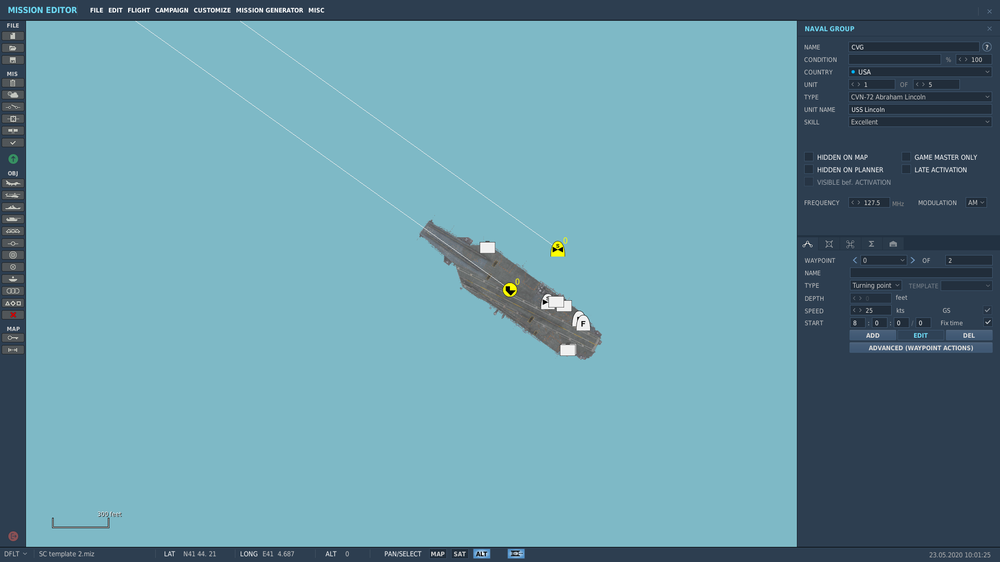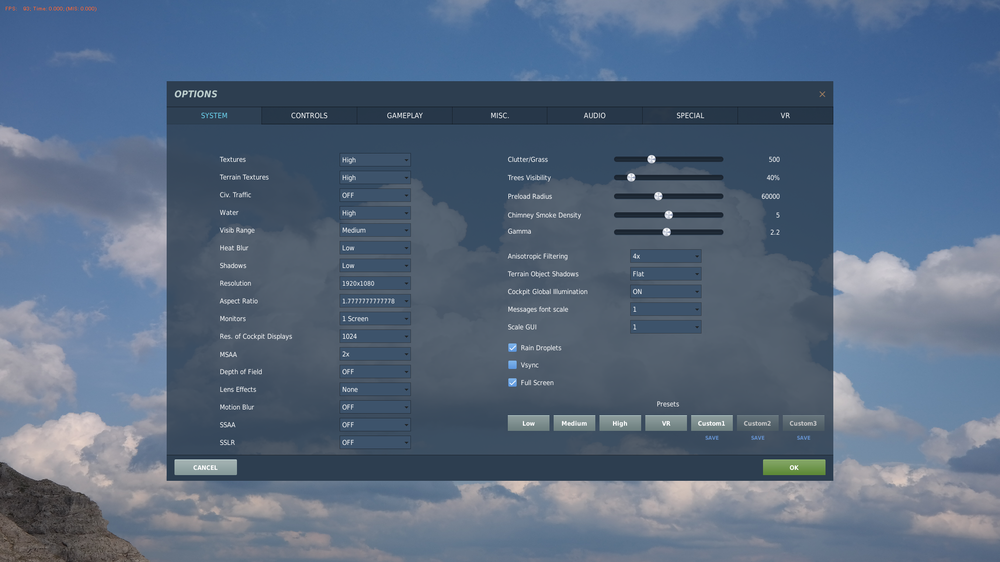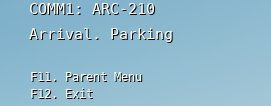-
Posts
544 -
Joined
-
Last visited
Content Type
Profiles
Forums
Events
Everything posted by Diesel_Thunder
-
AFAIK both radios are identical. What COMM1 button are you referring too? Normally one selects the active radio by pulling the correct radio knob (the one you use to select channels) out and releasing, using the left mouse button.
-
I typically use TOO mode as well. I am looking forward to when the new damage model is rolled out, as we should be able to take out the emitters with the HARM, instead of just inflicting overall damage as we have now.
-
Definitely a great community here :thumbup: Wanted to add a little more on braking. The brakes on most aircraft are very capable of stopping the aircraft using just the brakes. It is most certainly this way with civil aircraft. Generally you don't want to rely solely on the brakes, instead using what you have available to bring you down to a safe braking speed (drag chutes, speed brakes, aerodynamic braking, reverse thrust). One of the certification tests civil aircraft have to go through is a maximum takeoff weight (MTOW) rejected takeoff (RTO) test. In this test the aircraft is loaded with ballast to bring it up to MTOW, they start a takeoff roll and once at takeoff speed, perform the RTO. Using nothing but the brakes, the aircraft must come to a stop on the runway, stand for five minutes, and then be able to taxi clear. One of the conditions of the test is that it be performed with brakes that are mostly worn out, but just within service limits. Here's a short video of this being performed on a Boeing 777. Around a minute in you can see some of the fuse plugs on the wheels let go, which releases the air pressure in the tires in order to prevent tire explosions. When an event like this happens, the aircraft gets grounded and a thorough maintenance check on the gear is performed. Parts like hoses, brake parts, hydraulic actuators, fuse plugs, tires, etc. get overhauled or replaced prior to the aircraft being cleared for service.
-
Graf, thank you for your feedback. I did the takeoff from runway as a quick way to get to the heart of my problems and have a short track to upload. In my practice missions I normally cold start from parking and set both radiators wide open before startup. They stay that way until after I am in the air (whenever I do get off the ground). I'll practice with locking the tail wheel and then centering the stick as I roll. A few questions: Once the tail comes up, do I need to use a little forward stick to keep the mains on the ground to build up more speed? Lift off speed should be around 150 MPH to avoid lifting off in ground effect, correct?
-
I've noticed that as well, I start pretty much on the middle of the deck aft of cats 1 and 2. I usually takeoff from ramp cold. I don't think pre-defined parking spots have been implemented yet.
-
I just tried that, and while I was able to select all units from my mission, it only saved the ships into the template. It did not save the static units on deck or the rescue helicopter I have flying nearby. Starting to think this may not be possible. :unsure:
-
Oh, I see. I'm still a bit new at this. I did create a mission, instead of a template. I'll see if I can fix that and upload it later this morning. :pilotfly:
-
Here are three tracks from a mission I made, takeoff from runway hot. Full load of rockets on the wings. No rudder assist or auto rudder, 6º of rudder trim set. Not looking to good, never made it off the runway. P51 no assist.trk P51 no assist 2.trk P51 no assist 3.trk
-
You're welcome :) I'll be ordering a new SSD come payday (current SSD nearly full), at which point I'll be able to download the NTTR and Persian Gulf maps. I'll make a template for PG when I do. And the Marianas map whenever it comes out. Bet I could make a template for NTTR as well, but I doubt that the carrier could go far at 25 kts on Lake Mead! :megalol:
-
Definitely harder on the SC compared to the old Stennis. :joystick:
-

Why can't I drop two bombs at once (track file attached)
Diesel_Thunder replied to testudine2002's topic in DCS: F/A-18C
That's the correct setting for a pairs release, 2 bombs per release (QTY) in multiples of 2 (MULT). Since the two numbers match, there is no way to set an interval, since they drop at the same time. If you want to have some fun playing around with the QTY/MULT/INT release modes, create a practice mission and put a rack of 6 BDU-33 practice bombs on pylons 2,3,7, and 8. You'll get 24 "bombs" to practice with. Just keep one thing in mind on a ripple release, especially if you set wide spacing. The CCIP cross marks the center of the ripple pattern, not the beginning of it. -

Why can't I drop two bombs at once (track file attached)
Diesel_Thunder replied to testudine2002's topic in DCS: F/A-18C
I am not able to load your track file. DCS does not recognize that it's even there (I'm on open beta). However, here's how you set it up on your DDI stores page for Mk 82's: Mode - CCIP MFUZ - Nose EFUZ - INST or DLYx (your option depending on target) Drag - FF Now hit the UFC OSB over on the right side of the screen. You'll have some UFC options here on the UFC. This is where you can set up for multiple releases, either ripple or pairs. For ripple release: QTY - 2 or more MULT - 1 INT - Ground impact spacing in feet. This determines the release timing (interval) of the bombs to achieve the correct spacing. Hold the weapon release button until all bombs in the salvo are released so you won't risk a hung store. For pairs release: QTY - 2 (or more) MULT - match whatever you set in QTY. You won't have the INT option since it's a simultaneous release. Now your bombs will release in pairs on each press of the release button. Hope this helps. -
Here's a mission I created that works quite well on my machine, using USS Lincoln on the Caucasus map. The ship has some static objects for eye candy; couple of parked Hornets back aft, a parked SH-60 near the island, the crane aft of the island, a nearby tug, two LSO's at their station, and the fire cart up forward by cat 1. The deck is empty otherwise so you can put whatever aircraft you fly onboard. For active objects, there is a rescue SH-60 flying parallel with Lincoln just off the starboard side at 250 feet. There's a Perry class trailing at four miles. A Ticonderoga 1.5 miles off the starboard beam, and an Arleigh Burke at 1 mile from the port beam. There's another Arleigh Burke 7 miles ahead of the carrier. The groups course is 305 @ 25 kts. Lincoln's TACAN is 72X and reports as ABE in your HUD. ICLS channel 1. Comms are on 127.5 AM. Hope you guys find this useful :) EDIT: This is not a template, just a mission I created. I am in the process of creating SC templates and will upload them as soon as I finish them. SC template.miz
-
Nope, it is very specific and everything must be done correctly in sequence to insure success. I am new at this as well, and have been practicing this for about 3 weeks and still stink at it. The new Super Carrier is tougher than the old Stennis as well. Two videos that helped me out a lot and break it down are from Lex, and Jabbers: Bankler's excellent training mission for Case 1 landings is very helpful as well. It grades and gives feedback on all phases of the landing (initial, the break, downwind, the turn, and the groove). That mission uses the old Stennis, and is available here: https://forums.eagle.ru/showthread.php?t=221412 Three thing that also helped me out was breaking down individual stages of the sequence: 1 - Ignore the boat. Pick an airfield, and practice touch and gos. Use the TACAN to help gauge your distance from the field. When I did this, I would climb to 5,000 feet and do a long final. A 3º glideslope translates to about 300 feet descent per mile, 5,000/300=16.67 mile final. Once I got comfortable doing that at 5k feet, I dropped down to 4k and continued to practice, only reducing altitude as I got more confident. Refuel as needed, I ended up burning several tanks of fuel doing this. This helped learn the aircraft behavior. 2 - Ignore the boat. Set your bingo fuel to 2k. Take off from an airfield near water, and then go fly over the water at 800 feet. Get into landing configuration (hook, gear, full flaps, and on AoA) and work to maintain that 800 feet. This teaches you to work the throttle in order to maintain altitude. Your going to constantly work the throttle. Then do level turns at 30º bank. Turn 180º while maintaining 800 feet. Using cardinal directions (N, S, E, W) simplifies the math for your turns. Once you get the hang of that, do descents down to 600 feet, and then climb back up to 800 feet. Keep practicing the climbs and descents. Once you get that down, then do descending 180º turns, again 800 down to 600 feet. Keep practicing, and head back to your airfield for fuel once you get the bingo warning. Repeat as needed. 3 - Ignore the boat. Set your bingo fuel to 2k. Take off from an airfield near water, and then go fly over the water at 800 feet. Except this time, you are going to practice nothing except the break turn. Pick two opposing cardinal directions (N and S, or E and W) and fly that heading at 350 kts. When ready, throttle to idle, speed brake out, left bank to ~70º, and pull ~3G. Watch your attitude to maintain 800 feet. Gear out at 250, shallow your bank angle to 30º, half flaps at 220. Your speed brake should retract automatically when your flaps deploy, Full flaps around 190-180 kts. Stop your turn at 180º and get on trim. Fly like that a bit, then throttle up and clean up the aircraft (flaps up, gear up). Get back to 350 kts and do it again and again until you get the bingo warning. Land for more fuel and repeat as needed. Once you get comfortable with that, then try to do Case 1 landings on the boat. It's going to take a lot of practice. My three practice techniques above can be boring, but necessary to develop the skills needed. It helped me out. One other thing I learned the hard way, is that the bank angle scale at the the bottom of your HUD is not marked in 10º increments. It's marked off in 15º increments, with two little ones marking 5º. Not knowing this at first caused my turns to be too steep. Also, stop practicing if you are getting frustrated, take a break from it. Go blow stuff up for a while and come back to landings another time. I can't recommend Bankler's mission enough for this practice. Here's a screenshot of what his mission gives you for feedback after each approach: Good luck fellow rookie!
-
That can be a situational thing. Flaps down provides drag, but also generates lift. Increasing lift decreases the weight on your wheels, which can reduce the effectiveness of your brakes. A real life example of this was the early model of the Boeing 737 that used the JT8D engines (also used on the 727). They found that the thrust reverser not only was nowhere near as effective as planned, but also because the way the thrust deflected downward, it pushed the aircraft up. This reduced the weight on the main gear, and reduced the braking action in turn. Within 4 years they redesigned the reverser which gave much better reverse thrust and also did not push the aircraft up. For me in DCS, Kobuleti has become my home airfield. I base a lot of my missions from there. I just had to lookup the runway length and it was shorter than I thought, 7,870 feet. I haven't had many issues landing any of my jets there, though I did overrun the end in my Viper once. In the Hornet I come in on AoA, generally in the touchdown zone. Speed brake out, pull back on the stick, flaps stay down. Around the time I get to the tire marks on the far end is when I get on the brakes, and I'm generally down to 80 KIAS by this point. No issues getting down to 10 kts to make the turn on the last taxiway. Another thing to is you generally don't want to get on the brakes early so as not to overheat the brakes and cause them to fade or even start a fire. Not to mention that a brake overheat means more inspections and maintenance to make sure nothing was damaged. I don't think DCS models this behavior on the brakes. Energy increases with the square of speed, meaning that if you double the speed, you now have four times the energy (140 kts has four times the kinetic energy than 70 kts). And you don't want that amount of energy put into your brakes, which is why you want to bleed your speed down before getting on the brakes.
-
I believe you get instructed to taxi to parking when you call for a takeoff abort. It seems anytime you get told to taxi to parking is when this problem happens.
-
Speed brake out after touchdown. Pull back on the stick below ~125 KIAS to add more air drag from the tail. I get on the brakes around 70 kts to be able to slow down to taxi speed by the end of the runway. For the brakes, you have to map the left and right pedal under the axis drop down in the control setup page. And you might have to invert the axis on each pedal as well using the Axis Tune button. Some pedals, if you don't invert the axis, pushing the pedal releases the brake instead of applying them.
-
I read the thread in the bugs section about the FPS drop with the SC. I didn't change any of my settings just for the SC and what I get is pretty stable on a GTX 980 4G. So I wanted to share them to those that may be struggling a bit with the FPS on older cards. When I am on the deck of the Lincoln in my Hornet, I am getting 40-45 FPS, dipping to 35-40 FPS when looking back towards the island. Flying over water I am in the 70 FPS range, dropping to 55-65 while looking around in the cockpit. I have an assortment of static objects on deck consisting of 2 parked Hornets aft of the island, the crane, a tug, a parked SH-60 next to the island, 2 LSO's at their station, and the fire cart up forward near cat 1. For animated objects I have a rescue SH-60 flying just off the starboard side. Also have an Arleigh Burke 1 mile off the port side, and another 7 miles ahead. There's a Perry class 4 miles astern, and a Ticonderoga about 2 miles to starboard of the Lincoln. I do get some screen tearing when panning my head around while on deck, but I don't get any stuttering, or anything that kills my experience. Really digging the SC, the interaction with the deck crew adds a lot more immersion. I do realize I could up my performance with my system by reducing some of my settings, but I am not chasing raw performance. I have what I feel is a good balance between visual aesthetics and frame rate. Hope this helps my fellow pilots with lower end hardware! :pilotfly:
-
Thanks for the input everyone. I do want to note that I am setting rudder trim prior to taking the runway. Sometimes I also put some nose down trim if my wings have weapons mounted. I always lock the tail wheel prior to throttle up. And I ease into the power as I start, all the way to 61" MP. Fishbed, I don't have pedals or a twist stick. I have a rudder rocker on the backside of the throttle that is suppose to be used by the middle and ring fingers of the users left hand (picture in my first post). A twist stick would be better than this thing. With or without the rudder assist seems to give me the same result. As I roll down the runway, I tend to drift left of center, which I try to correct, and typically do. Once the tail comes up, I get a bigger pull to the left. With a little forward stick to keep the mains on the runway (still around 100 kts), I attempt to correct the left pull. I'll either under correct and end up in the grass or over correct and end up in the grass on the other side of the runway. By this point I've lost control, and end up with a wrecked aircraft. It certainly feels like I don't have the fine control over the rudder that I need with my current HOTAS. The P-51 is my absolute favorite warbird. I'm starting to think I may have to shelve this bird until I get better hardware. I'll post a track either tonight or tomorrow when I fly. Maybe that will shed some light on things.
-
I got waved off several times doing approaches (which I still suck at) today. I all cases, all I did was fly 4 miles behind the carrier, Lincoln in my mission, and start over. I never did have to call inbound a second time. I suspect that getting away from the carrier outside of an unknown specific distance will reset the IFLOLS (Improved Fresnel Lens Optical Landing System).
-
With the Super Carrier, I learned that I can reset the catapult crew using the ground crew menu, so no issue with them at the moment. The ATC radio comms problem on the other hand still exists. I do want to note that I've experienced this error in all my aircraft. Here's a track and log file where I did a cold start and pattern around Kobuleti in the F-18. I radioed ATC at the proper times, and got the expected responses each time until after I landed. When your speed falls below 20 knots on the runway, ATC will instruct you to taxi to parking, and that is the last comm I got from ATC. I taxied back to my original parking spot. No further ATC options, but I can interact with the ground crew just fine. Open Beta 2.5.6.49314 Radio call times in track: 10:02:10 - Start-up request 10:04:40 - Requested taxi 10:07:40 - Request takeoff 10:10:07 - Inbound 10:11:10 - Request landing All calls to this point were properly answered by ATC. From here on there are no further options with Kobuleti ATC (see screenshot) 10:13:52 - Instructed to park 10:16:50 - Interact with ground crew Ground crew responded as expected. ATC error.trk dcs log 2.txt
-
It the same problem I’ve noticed across 3 updates: https://forums.eagle.ru/showthread.php?t=274133 I plan on running a quick trip around the pattern at an airfield, cold start, and posting the track file and log once I get home from work.
-
Forgot to post the log file. Here that is. dcs log.txt
-
I'm having an issue with the ATC comms, and it has happened consistently for me across three updates (open beta 47224, 47404, and 49314). Almost all of my SP missions, I cold start at the ramp. I'll do the usual start up request, taxi and takeoff requests. After I land is when my problem starts. Whenever I land in order to refuel/repair/rearm, I no longer have taxi to runway in my comms menu. Thus I can never request to taxi or takeoff after landing. If I takeoff anyway, I can call ATC for landing and that will work. Ground crew comms works at all times while on the ground. This happens no matter what airfield I land on, old Stennis, or even the new Super Carrier. Because of this comm problem, I cannot reset the deck crew on the SC in order to takeoff again. The attached screenshot is all I see in the comms menu after landing. I don't think I am doing anything wrong with my procedures. I am not using simple comms. I did a repair and it found nothing wrong. I'm not sure what to do at this point.





